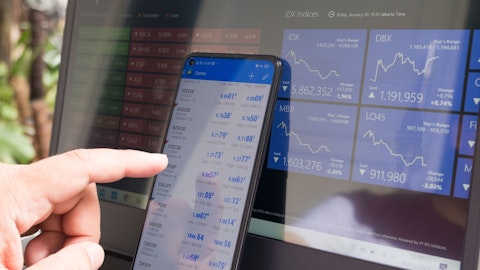Tim Power: Thanks, David, and thanks for the question, Seamus. Keith, can we go to the next question, please?
Operator: Certainly, and that comes from Chris Shibutani with Goldman Sachs.
Chris Shibutani: Thank you very much. You’ve made some comments about Sotyktu and the reimbursement environment as that is evolving, and the constraints that you have. Perhaps for Adam or whomever would be appropriate, could you comment further about what you’re seeing there and how we should be thinking about the cadence? I think the set-up had been that ’24 would be an opportunity, and that seems to be slightly different.
Adam Lenkowsky: Chris, thank you for the question. First, I want to say we’re very pleased with the performance of Sotyktu. Our goal remains to be the standard of care in the oral market. In fact, as you heard, we have achieved now a 40% share of newly written prescriptions and we’re the third most newly prescribed systemic therapy, and we’ve done that in a little over a year post launch. Now as you have stated, our focus really is around accelerating access, and we anticipate achieving broader access in 2024 and continuing in 2025. Remember, today Sotyktu is not covered on approximately 80% of lives in the United States, and so we expect to see significant improvements coming next year. We’re in the throes of negotiations with the PBMs, so we would expect to see a marked improvement in 2024 and that could continue into 2025, where we would expect to have very broad access across the other two PBMs. We’re very confident in our ability to achieve that.
Tim Power: Terrific, thanks Adam. Could we go do the next question please, Keith?
Operator: Yes, certainly, and that comes from Steven Scala with TD Cowen.
Steven Scala: Thank you very much. Regarding the midterm guidance changes, I’m a bit puzzled as to why now, particularly when you had a major meeting last month and time to go through the specifics – I’m sure these changes were evident at that point, or wait until Q4 when you have to set the stage for 2024 and beyond. I think the answer will be that that was an R&D meeting last month, but still, Chris, you opened the meeting by kind of setting the stage and tone for the company, so I’m just wondering why you’re setting these changes in on a Q3 call. Thank you.
Chris Boerner: Sure Steve, let me take that, and then David can provide additional color. The timing of the shift is really driven by the fact that in the short term, we have seen additional trends mainly around Abecma that have required that we change our short term guidance, and that’s giving the guidance for the new product portfolio for this year. Now as we’ve said, we expect that portfolio to be roughly $3.5 billion this year, and that is slightly less than what we had anticipated when we began this year. As a result of that change and what we’re seeing with the new product portfolio, the dynamics of which I described in the prepared remarks, we made the decision that we wanted to update the ’25 guidance as we anticipated that would be a question that would come out on this call, and so that’s why we made the decision to change the 2025 guidance.
Then of course, as we get into next year, we’ll provide additional color as to how we expect 2024 to proceed. That was really the motivation for the timing of why we decided to make the changes in guidance today.
Tim Power: Thanks Chris. Keith, can we go to the next question, please?
Operator: Certainly, and that comes from Terence Flynn with Morgan Stanley.
Terence Flynn: Hi, thanks for taking the questions. I guess Chris, maybe for you, just the launch reboot strategy for some the drugs that have come in below your expectations, maybe you could just walk us through each of those and some of the steps you’re taking, and why you’re confident that that’s going to have success. Thank you.
Chris Boerner: Sure Terence, let me start and then I’ll ask Adam to provide some specifics really around the products where we think we’re going to need to have either a reboot or where we are moving to accelerate. I think the way I characterized it in the opening remarks is right – we have a number of products which are either hitting or exceeding our expectations. Certainly Opdualag, Reblozyl is performing very, very well. Breyanzi, as David alluded to, we saw good performance in the quarter, but importantly, we’re seeing very strong manufacturing performance and we anticipate both supply and the quality of manufacturing for that product to improve, and given the profile of the drug, we have every expectation that’s going to continue to perform very well as we get into 2024, so those products, we feel very good about.
For Sotyktu and Camzyos, the dynamics are the products are just taking a bit longer and the trajectory for those products requires that we think about the time to peak being shifted back. What’s important, and Adam can speak to this, is the fundamentals for both of those products continued to be very, very strong. We’ve got good, strong share for Sotyktu, we anticipate given the quality of that data and what we’re seeing from customers, this will become the oral standard of choice, which is remember what the objective was when we launched the product. For Camzyos, every metric across this product, whether it relates to how physicians see the product and how patients see the product, remains very strong. The dynamics in the cardiovascular market are such that that’s just simply going to take a bit longer.
I’ll have Adam speak to any additional color on those two product, but mainly focused on Abecma and on Zeposia.
Adam Lenkowsky: Yes, thanks Chris, and thanks Terence for the question. Let me just add a little bit more color. As you heard, we have said that we’re seeing continued impact from additional BCMA agents pressuring Abecma growth, and so our teams are focused on, number one, expanding our site footprint both in the U.S. and internationally. We’re differentiating and contextualizing Abecma real-world data for physicians, which really look very similar and consistent with our clinical trials, and we’re educating on sequencing and some of the emerging data that the use of self-therapy ahead of bi-specifics is ultimately better for patient outcomes. We’re also very pleased with the progress we made on manufacturing around our predictability and low out-of-spec rates, so that’s what we’re really doing around Abecma.
As it relates to Zeposia, as Chris mentioned, and then I’ll shift to the others, we continue to see quarterly demand growth. MS is really driving that growth, and so we’ve made a lot of progress on the MS front even in a declining oral market in favor of B-cell, and so we continue to expect growth in the MS market. Now, we have certainly an opportunity for continued growth in UC. We’re making progress, but our access challenges there, they remain, and we’re working to improve our access position. But we’re also seeing progress in Zeposia in the first line setting post ASA as physicians are identifying Zeposia really as a good treatment option based on its efficacy and safety profile, so we’re focusing there on expanding breadth of prescribing and continuing to really drive adoption across a broader use of physicians.
For those reasons, we do expect to see continued growth and uptake for Zeposia. Now as it relates to Camzyos and Sotyktu, as Chris opened, he talked about the importance of those two products and really not a matter of if, but a matter of when, and that’s why we made that decision. For Camzyos, we are pleased with the uptake there. The focus on Camzyos remains to continue to increase our breadth in our COEs, go outside of the COEs to the non-centers of excellence to expand utilization. We’re seeing doctors are much more comfortable in using, and the patient response has also been very, very strong there, and continuing to bring patients out of the hub. Remember, these patients are going to be on treatment for a very long time. Then finally, again I’ll just close on Sotyktu, I mentioned some of the key areas that we’re focused on around access, and David talked about pulling through those patients through the hub, but we also continue to drive breadth of prescribers, where we’re making really meaningful progress and reinforcing our superior efficacy profile compared to Otezla.





